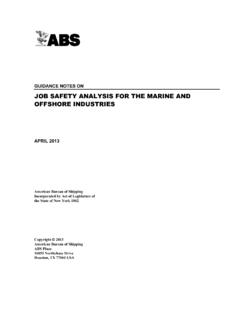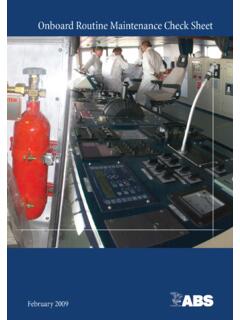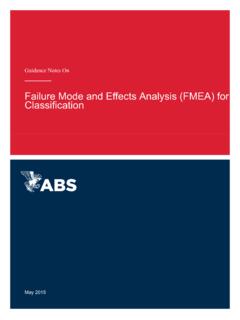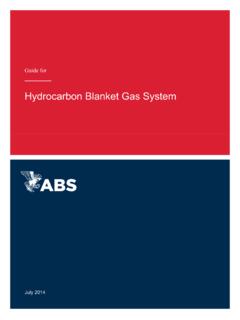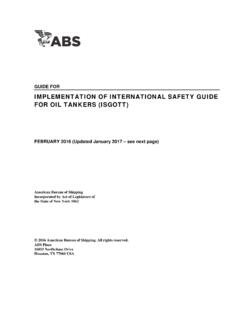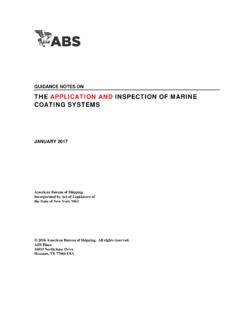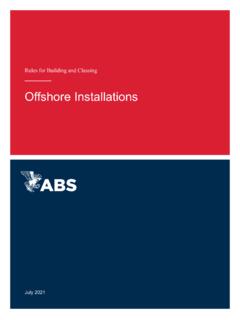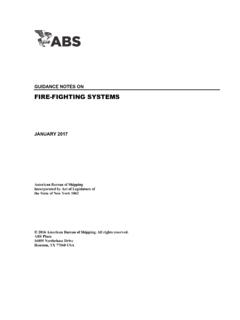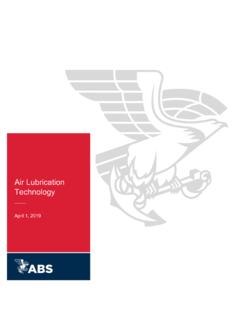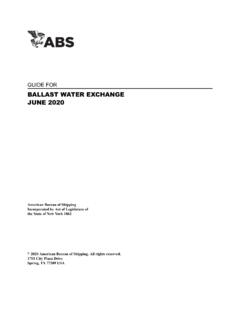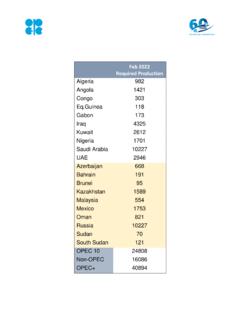Transcription of Ammonia Fueled Vessels
1 Guide forAmmonia Fueled VesselsSeptember 2021 GUIDE FORAMMONIA Fueled VESSELSSEPTEMBER 2021 American Bureau of ShippingIncorporated by Act of Legislature ofthe State of New York 1862 2021 American Bureau of Shipping. All rights Plaza1701 City Plaza DriveSpring, TX 77389 USAF orewordDue to increased commitment from the International Maritime Organization (IMO) to reduce Green HouseGas (GHG) emissions from shipping, the use of Liquified Natural Gas (LNG), methanol, ethane, LiquifiedPetroleum Gas (LPG), hydrogen, Ammonia and other gases or low-flashpoint fuels are expected to becomemore widely adopted by the marine industry as a substitute for conventional residual or distillate marinefuels. In response to the IMO GHG reduction targets, the marine industry has increased its interest in theuse of Ammonia as a marine fuel due to the zero-carbon fuel properties and ability to produce ammoniafrom renewable and sustainable sources.
2 This Guide addresses the use of Ammonia as a marine ABS criteria to be applied to gas or other low flashpoint Fueled ships are detailed in Part 5C, Chapter13 of the ABS Rules for Building and Classing Marine Vessels (Marine Vessel Rules), which incorporatesthe IMO International Code of Safety for Ships Using Gases or Other Low Flashpoint Fuels (IGF Code).The application of this Guide is for Vessels covered by the IGF Code as addressed by 5C-13 of the MarineVessel Rules. ABS will consider application of this Guide to liquefied gas cargo vessel covered byInternational Code for the Construction and Equipment of Ships Carrying Liquefied Gases in Bulk (IGCCode), as addressed by 5C-8 of the Marine Vessel Rules, on a case-by-case applicable edition of the Marine Vessel Rules is to be used in conjunction with this Guide becomes effective on the first day of the month of are advised to check periodically on the ABS website to verify that this version ofthis Guide is the most refer to the ABS Sustainability Whitepaper: Ammonia as Marine Fuel, for supplemental informationon Ammonia as a marine welcome your feedback.
3 Comments or suggestions can be sent electronically by email GUIDE FOR Ammonia Fueled Vessels Low Flashpoint Fueled Ship - Fuel Diesel Engine Power Administration and Data to be Arrangements and Containment Bunkering Supply Generation Prime Movers and and Functional FORAMMONIA Fueled VESSELSABS GUIDE FOR Ammonia Fueled Vessels of Explosion Design and 244 Machinery Space (Engine Room) and Protection of Fuel Preparation Room .. , Openings and Water of Fuel Preparation GUIDE FOR Ammonia Fueled Vessels of Entrances and Other Openings in Safety and Containment Relief and Loading Limit for Fuel Fuel Storage Control Within the Fuel Containment .. GUIDE FOR Ammonia Fueled Vessels 2021v10 Atmospheric Control Within Fuel Storage Hold Spaces.
4 Gas Arrangements .. and Refrigeration Systems .. and General Pipe Pipe 355 Bunkering Supply to GUIDE FOR Ammonia Fueled Vessels 2021vi4 Redundancy of Fuel Functions of the Fuel Supply Distribution Outside of Machinery Supply in Gas Safe (Non-Hazardous) Machinery of Fuel Piping Ventilated Duct or Outer and , Heat Exchangers and Pressure Generation Including Propulsion and Other GUIDE FOR Ammonia Fueled Vessels Fuel Spray Station Fire-Extinguishing Detection and Alarm Extinguishing of Engine Room and Fuel Prevention, Area Classification and Toxic Area Area Zone Area Zone GUIDE FOR Ammonia Fueled Vessels Area Zone Connection Preparation of the Fuel Preparation Ventilation of the Fuel Preparation and Double , Monitoring and Safety GUIDE FOR Ammonia Fueled Vessels and Liquefied Fuel Tank Detection Functions of Fuel Supply and Safety 1 Monitoring and Safety , Manufacture.
5 Workmanship and and Emergency GUIDE FOR Ammonia Fueled Vessels GUIDE FOR Ammonia Fueled Vessels 2021xiSECTION 1 Introduction1 ScopeThe international regulations pertaining to gas or other low flashpoint Fueled ships, other than thosecovered by the IGC Code, are those included in the IMO International Code of Safety for Ships UsingGases or Other Low Flashpoint Fuels (IGF Code), which entered into force on 1 January 2017. The IGFCode has been incorporated along with ABS requirements in Part 5C, Chapter 13 of the ABS Rules forBuilding and Classing Marine Vessels (Marine Vessel Rules).The IGF Code currently only includes detailed prescriptive requirements for natural gas (methane)applications. All other low flashpoint fuels or gases must demonstrate an equivalent level of safety byapplication of the Alternative Design methodology as specified in International Convention for the Safetyof Life at Sea (SOLAS) Chapter II-1 Regulation 55 and guidelines referenced by footnote or associated guidelines other prescriptive IMO requirements exist for particular gases or other low flashpoint fuels, eitherby regulation, or as interim guidelines, these may be applied in lieu of the Alternative Design criteria,subject to agreement by the flag Administration.
6 At present, no such IMO instruments exist for the use ofanhydrous Ammonia as Guide provides guidance for the design, construction, and survey of Vessels utilizing anhydrousammonia ( Ammonia ) as fuel. This guide is focused on systems and arrangements provided for the use ofammonia for propulsion and auxiliary objective of this Guide is to provide Classification criteria for the arrangements, construction,installation and survey of machinery, equipment and systems for Vessels operating with Ammonia as fuel inorder to minimize risks to the vessel, crew and Low Flashpoint Fueled Ship - AmmoniaThe LFFS notation is required and will be assigned where a vessel is arranged to burn Ammonia forpropulsion and/or auxiliary purposes and is designed, constructed and tested in accordance with therequirements of this Guide.
7 The LFFS notation will be assigned in association with the specific fuel andone or more of the following additional equipment notations ( LFFS(DFD - Ammonia )). Vessels seeking the LFFS notation for Ammonia as fuel are also to meet the criteria and be assigned theACC, ACCU or ABCU notations for remote monitoring (See also 5 of this Guide).Commentary:ABS GUIDE FOR Ammonia Fueled Vessels 202112 Conventional fuel flashpoint testing refers to closed cup testing of fuel oils and hence is not an applicable test for gases. Forthe purposes of this guide, the LFFS notation is applied to IGF Code Vessels on the basis that the process of the IMOA lternative Design process is :See also 5C-13-1 of the Marine Vessel Rules for more information on ABS notations for IGF Code of Fuel Diesel Engine Power PlantWhere a dual fuel diesel engine power plant is installed, the DFD notation is required and the unit is to bedesigned, constructed and tested in accordance with this Guide and the Marine Vessel SystemWhere a Reliquefaction or Refrigeration System is installed, the RELIQ notation is required and the unit isto be designed, constructed and tested in accordance with this Guide and the Marine Vessel design review, survey, testing, and the issuance of reports or certificates constitute the certification ofmachinery, equipment and systems.
8 See also 4-1-1/3 of the Marine Vessel Administration ApprovalWhere the conditions of the Guide are proposed to be used to comply, or support, the IGF CodeAlternative Design process, such application is subject to approval by the Flag Administration prior toissuance of relevant statutory certificates on behalf of the same Flag Administration by :Refer to 5C-13-2/3 of the Marine Vessel Rules for the IGF Code Alternative Design of Commentary6 FormatThis Guide is based on the technical requirements of the International Code of Safety for Ships UsingGases or Other Low-Flashpoint Fuels (IGF Code) which is contained in its entirety in 5C-13 of the MarineVessel Rules and is required for term shall be is to be understood to read as must be or is to be or are to be and unlessotherwise specified. The term Administration as used in this Guide is to be read as FlagAdministration (See Subsection 1/5).
9 This Guide specifies only the unique requirements applicable to Vessels using Ammonia as fuel. This Guideis always to be used in association with the IGF Code, as incorporated in 5C-13 of the Marine VesselRules, and with other relevant Sections of the this Guide includes cross references to Parts A-1, B-1 and C-1 of the IGF Code (Sections 5C-13-5to 5C-13-18 inclusive) of the Marine Vessel Rules, the terms natural gas , LNG or gas , as related tofuel, are to be understood to be referring to anhydrous Ammonia for application of the requirements of text contained in this Guide that comes directly from the IGF Code is presented in italics Times NewRoman GUIDE FOR Ammonia Fueled Vessels 202113 SECTION 2 General1 ApplicationThis Guide is to be applied to both new construction and existing vessel conversions, regardless of size,including those of less than 500 tons gross tonnage, utilizing Ammonia as.
10 This Guide has been developed for application to ships covered by the IGF Code. ABS will consider application of thisGuide to ships falling under the scope of the IGC Code on a case-by-case basis, provided such proposals are arranged inaccordance with the requirements of the IGC Code, demonstrate the same level of safety as natural gas and with agreementof the flag of Commentary2 DefinitionsFor the purpose of this Guide, the terms used have the meanings defined in the following not defined have the same meaning as in 5C-13-2/2 of the Marine Vessel ) Engine room is a machinery space containing Ammonia Fueled engine(s).ii) Fuel means anhydrous Ammonia (NH3) in its liquified or gaseous state. The terms fuel Ammonia and NH3 used in this Guide refer to anhydrous ) Gas dispersion analysis is the analysis of the dispersion behavior of gases using appropriatemodeling techniques such as computational fluid dynamics (CFD) ) Gas freeing is the process carried out to achieve a safe tank atmosphere.
